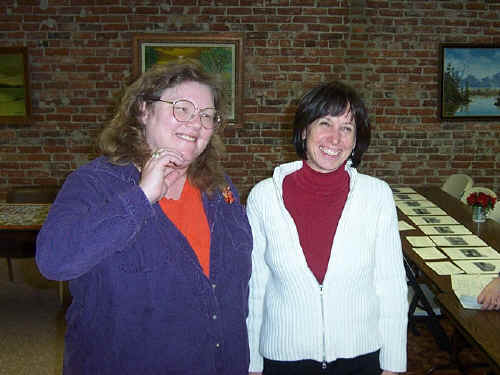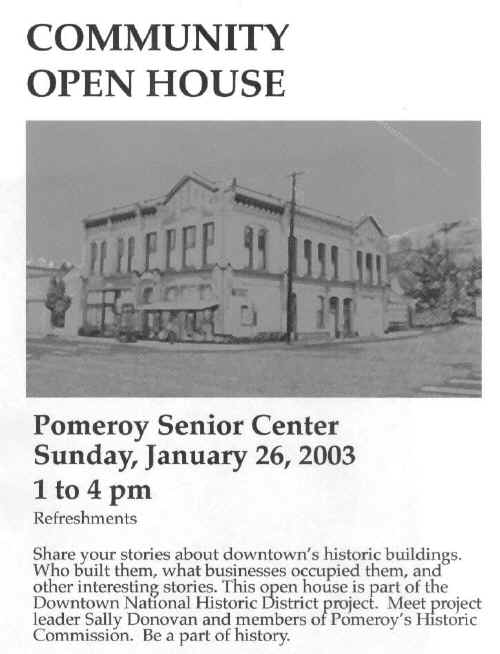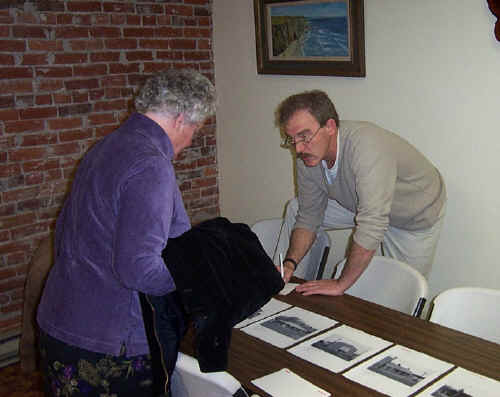
How Pomeroy’s Historic District Was Born
On February 16, 1999, Beverly and John Gordon purchased the historic Hotel Revere in downtown Pomeroy, Washington. Shortly after purchasing the building, Beverly began researching its history because she learned from various community members bits of the important role the building and its site played in the development of Pomeroy and Garfield County. Always a history buff and a former National History Day Advisor, she began serious research into the building and its various owners most importantly Martha Pomeroy St. George and Harry St. George. She soon realized that the building might qualify as a National Historic property because the oldest part of the building, (the brick "annex") was built in 1888, the three-story part was finished in 1902, and that the foundation of the “three story” section was from the original Pomeroy Hotel which was built in 1874. She also learned that the town’s founders built the whole town around their original, 1874 stage stop. Because it had been host to three different Presidents, numerous governors, and other famous persons she thought it must certainly qualify as an historic property.
Early in 2000, Beverly Gordon contacted the National Historic Properties offices in Washington, D.C., to learn more about the process and possibilities of designation as an historic property. After emphasizing there were no longer grants or loan programs for Historic Preservations, the representative agreed that the property most certainly did qualify and he promised to send her information about application process. Then he told Beverly she should contact her state’s Historic Preservation Dept. (now known as the Dept. of Archeology and Historic Preservation) in Olympia because before national designation could happen, the building must first be listed as a Washington State Historic Site and they sometimes have funds or persons to assist in the complicated process of the applications.
When Beverly called the State office and explained her needs, she was immediately put on the phone with the State’s Architectural Historian, Allyson Brooks, who was the person in charge of helping building owners and others get listed on the state and national historic registers. Throughout the conversation, she repeatedly emphasized that the state and national offices had no funds for helping with preservation of a building. Since Beverly and John Gordon’s main interest was not in receiving funds, but making sure they did not do anything in their restoration that would harm the chances of having their building listed on the State and National registries. Ms. Brooks was excited to hear from a building owner purely interested preservation advice, not seeking money or grants. She agreed to come by the hotel for a visit when she was in the area. She made no promises of when that would be.

Committee Member Beverly and consultant Sally Donovan
A few months later, she came at a very opportune time. The Gordons had just finished the internal "demolition" of the building and organizing the saved materials removed during that process. Allyson spent the day with Beverly and John pointing out things that they needed to know, like not to change the exterior of the building other than paint colors and glass replacement. She even helped Beverly determine the original colors of the three-story building's front. Allyson also emphasized the importance of maintaining the style, placement, and materials of the windows. She sternly warned that using vinyl windows and filling in arched windows with wood to make them smaller and square would be damaging to the building’s historic value.
On the interior she said the Gordons could actually do or change whatever they wanted since the historic designation generally only deals with the outside of buildings, with rare exceptions. When John, told her that they were hoping to maintain the feel and materials of the historic building, Allyson pointed out considerations they should pay attention to including the rhythm of the interior doors and the central halls and entryways. Upon return to her office, the State Historian sent Beverly reams of documents and newsletters on the “how-to” of historic restoration along with a subscription to the National Historic Restoration Newsletter. Another resource she sent to the Gordons was a list companies and consultants the State of Washington used to help with their own preservation and restorations work. The list included the names of architects, engineers and other specialists qualified in historic restoration. She included instructions and forms along with forms used by similar properties to gain designation as historic sites. When the Gordons saw how involved the process was, John and Beverly -- who were currently working on renovating the historic property, running a business, and home educating their youngest daughter -- gave up on the idea of designation and just worked on keeping it as historically accurate as possible.
Two years later, while reviewing and cleaning out her files, Beverly came up with the information from Allyson Brooks had sent her. "I'm going to give her a call," thought Beverly. "I want to update her on the progress of the building’s renovation and who knows maybe some things have changed.”

Things had changed in many ways at the state level! Allyson Brooks now worked in a new job as Director of Historic Preservations and there was now a new State Architectural Historian, Michael Houser (no relation to the Garfield County Housers), a graduate of Washington State University. Michael was interested in what Beverly was asking about. He explained to Beverly that he and his wife were planning a trip to visit her parents who lived in Pullman. So, "I'd be happy to come and talk to you in person," he said. "But remember, getting a building or district on the registery can be very expensive and there is no grant (free) money available."
Michael Houser came to Pomeroy, on his way to Pullman, and spent several hours talking with Beverly and John while he toured their building and pointed out various things that they should consider while working on the second floor. He also toured the Seeley Theatre along with then owner Zack Lueck giving him many useful suggestions. After lunch, Mr. Houser and his wife took a self-guided tour through the various neighborhoods of Pomeroy. “This town is lucky,” he told them. “While Pomeroy was a prosperous farm community, it was never rich enough so that the downtown merchants or the citizens could spend their money on modernizing their buildings.” According to Houser, “Most of the downtown has changed little since the various buildings were built.”
Houser added that “Pomeroy is unique in that its neighborhoods has examples of all the architectural styles from its founding to present day.” “In fact,” he said “When I was at WSU, our Professor of Architectural History used Pomeroy as an example and we toured the community on a field trip. I fell in love with Pomeroy at that time.”
Several weeks after Houser's visit, he called Beverly to tell her that while he had told her earlier there was very limited or no "free" money for historic preservation designation status, actually there was one new grant available. Houser told Beverly that there was a $20,000 fund earmarked to help a community gain Historic District Status. He was sure Downtown Pomeroy qualified for the grant! It was part of the State’s effort to preserve the look and feel of rural Eastern Washington towns and create a tourism byway along Highway 12. Pomeroy was the only town on this Historic Byway that did not already have a Historic Preservation District. He suggested to get started we would need a small group of people who had historic properties in the city limits of Pomeroy to form a committee. The funds had to go through a city government or a 501 corporation. The committee’s role was exploratory and to petition the City Council about applying for the grant and as a working body for the beginning of the Historic Preservation applications with a Historic Preservation consultant.
The first person John and Beverly roped in to serve on the committee was their friend, Zack Lueck who owned at that time the Seeley Opera House located across from the Hotel. Zack and partner Al(berta) Godinez had been instrumental in saving many downtown buildings from destruction and at various times over the preceding decade had purchased many of the stores and buildings along Main Street in auctions. Some of those buildings included the Seeley Opera House, the American Legion Building, The Palace Store, A.D. Fox & Son Building, and others. John and Zack were both city council members at the time.

Committee Member Zack Lueck and Juyne Bowles.
The $20,000 grant was to be used to pay for the historical preservation consultant who would be able to do all the work needed to gain the historic districts status. Mr. Houser gave the committee a list of consultants that were acceptable to the state and federal preservation offices. The committee recommended that the city hire Sally Donovan of Donovan and Associates out of Hood River, Oregon, for the task. She was available to begin as soon as given the go ahead by the city and was willing to do the task for the grant amount even if it was under her billable hours. Ms. Donovan and her partner virtually did all of the work filling out the extensive documentation and research on the different buildings in downtown and drew up a map of what would be the Downtown Historic District. She, with the committee’s help, organized all of the required community meetings. Adams-Gordon handled keeping the press informed about the process and events related to the Historic Preservation Committee’s work.
Downtown Pomeroy was first entered on the State Historical District Register in June of 2003. A few months later on August 21, 2003, it was entered on the National Historic District Register. Part of the requirements for the Historic District status was to have an official body that reported to the City Council and made recommendation to the taxing bodies regarding those properties that qualified for property tax credits for various preservation work, thus the Pomeroy Historic Preservation Commission was born. The original group included the committee members and a few others. Members were to be historic property owners residing within the city of Pomeroy. Each of the commission members served as a representative to different classes of historic properties e.g. commercial, residential, institutional (schools and government buildings), and representatives with historic organization and a member at large. Beverly Adams-Gordon was selected the Chairman of the Commission and served in that role for two terms. Other original Commission members were Zack Lueck, Marjorie Allmaras, Lisa Lund, Al Godinez, Maxine Cox and Bruce Crossfield. Soon after its formation, Zack Lueck was replaced by Brad Gingerich as it was learned that a member could not serve on both the Commission and the City Council.
The "Pomeroy Historic Preservation Committee" remains in existance as an informal group of citizens interested in preserving Pomeroy's history and educating the community on historic preservation. They produced the reprint of the 1909 WCTU "Good Things to Eat" Pomeroy cookbook and maintain the HistoricPomeroy.com website with financial support from Castlemoyle Books and Gifts of Pomeroy.
